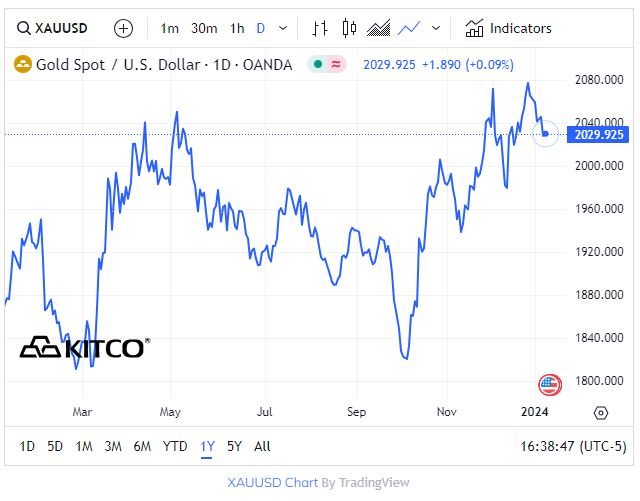Gold prices have been close to 30-year highs,¹ allowing consumers and businesses to sell potentially at a higher price.
The recent decline in gold production has contributed to a higher gold price. Gold mine production rose from 2,560 metric tons in 2010 to 3,300 metric tons in 2019 before decreasing in 2020. Gold mine production was 3,100 metric tons in 2022, about the same level of production as 2015.2
Price of Gold Per Ounce Today
Per Kitco, the price of gold is $2,340.41 per ounce as of April 26, 2024.
Why the Price of Gold is Important
When the Federal Reserve Bank of Chicago looked at what drives gold prices, they studied three factors:
- Gold is a hedge against inflation
- Gold is sensitive to expected long-term real interest rates
- Gold is regarded as protective against “bad economic times3
What is the gold spot price?
The spot price of gold is the market price an ounce of gold could be bought or sold for right now. It is typically based on the opening market price on the day that it’s purchased. In contrast, gold futures are the predicted price of gold at a future point. Gold futures are determined by predicting supply and demand changes, as well as how much it will cost to transport and store gold.
When Cash for Gold USA makes offers to buy gold, we use Kitco’s spot price on the day your items are evaluated.
How the Gold Spot Price is Calculated
The spot price of gold is determined by a combination of factors, like the supply and demand for gold in the market, production from gold mines, gold jewelry production, and economic uncertainty. Also, the trading of gold futures has a significant impact on the spot prices, as they reflect the current and future expectations of market conditions.4
The study concluded that the price of gold often acts like an economic indicator, when there is uncertainty in the economy and expectations of inflation, investors often turn to gold as a safe haven investment, protection against bad economic times.3
Gold Pricing Chart and Historical Data
Historical Trends in Gold Pricing5
For about twenty years (from roughly 1985 to 2005), the price of gold was somewhat steady, fluctuating between $300 to $500 per ounce. The price of gold was on a general upward trend between 2005 and 2011, before dropping in price into 2015. It has since been rallying for the most part. The price has been above $1,500 since early 2016, and was around $2,000 at the end of 2023.1
Gold Price FAQs
How much is an ounce of gold?
Gold is weighed using troy ounces. A troy ounce is around 31.1 grams, compared to a regular ounce, which is 28.35 grams.
How much is a gold bar worth?
A gold bar weighs around 1 kilogram, or 2.2 pounds. It is around 32 troy ounces. To determine how much a gold bar is worth, multiply the spot price of gold times 32. So, if the spot price of gold is $2,000, then a gold bar would be worth roughly $64,000.
What is 1 gram of gold worth?
To calculate what 1 gram of gold is worth, divide the spot price of gold (based on a troy ounce) by 31.1 (the number of grams in a troy ounce). This will give you the approximate price of 1 gram of gold. If the spot price of gold is $2,000, then 1 gram would be around $64.31.
Per Kitco, the price of gold is $75.50 per gram as of April 26, 2024.
More on how to estimate what your gold is worth.
What is the gold price vs silver price?
Gold is much more valuable than silver.
Per Kitco, the price of gold is $2,340.41 per ounce whereas the price of silver is $27.63 per ounce as of April 26, 2024.
Sources:
1. Gold Price – Gold Price History, https://goldprice.org/gold-price-history.html. Retrieved Dec. 22, 2023.
2. Statista – Gold mine production worldwide from 2010 to 2022, https://www.statista.com/statistics/238414/global-gold-production-since-2005. Retrieved Dec. 23, 2023.
3. The Federal Reserve Bank of Chicago – What Drives Gold Prices? https://www.chicagofed.org/publications/chicago-fed-letter/2021/464. Retrieved Dec. 23, 2023.
4. Bullion by Post – Who sets the price of gold?, https://www.bullionbypost.co.uk/index/gold/who-sets-the-price-of-gold. Retrieved Dec. 23, 2023.
5. Kitco – Historical Trends in Gold Pricing, https://www.kitco.com/price/precious-metals/gold. Retrieved Jan. 4, 2024
About Cash For Gold USA
Cash for Gold USA is a prominent online buyer of gold, silver, platinum, and palladium in the United States. Since 2005, we have paid millions to thousands of customers for their unwanted or broken precious metal jewelry. We offer a quick and straightforward selling process, ensuring customers receive prompt and competitive offers for their items. Learn more about us and what our customers say about Cash for Gold USA, or request your free Appraisal Kit now:



